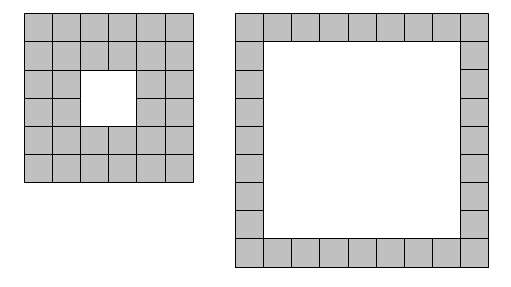* fix: clean-up Project Euler 161-180 * fix: corrections from review Co-authored-by: Tom <20648924+moT01@users.noreply.github.com> Co-authored-by: Tom <20648924+moT01@users.noreply.github.com>
1.6 KiB
1.6 KiB
id, title, challengeType, forumTopicId, dashedName
| id | title | challengeType | forumTopicId | dashedName |
|---|---|---|---|---|
| 5900f41a1000cf542c50ff2d | Problem 174: Counting the number of "hollow" square laminae that can form one, two, three, ... distinct arrangements | 5 | 301809 | problem-174-counting-the-number-of-hollow-square-laminae-that-can-form-one-two-three-----distinct-arrangements |
--description--
We shall define a square lamina to be a square outline with a square "hole" so that the shape possesses vertical and horizontal symmetry.
Given eight tiles it is possible to form a lamina in only one way: 3x3 square with a 1x1 hole in the middle. However, using thirty-two tiles it is possible to form two distinct laminae.

If t represents the number of tiles used, we shall say that t = 8 is type L(1) and t = 32 is type L(2).
Let N(n) be the number of t ≤ 1000000 such that t is type L(n); for example, N(15) = 832.
What is \sum N(n) for 1 ≤ n ≤ 10?
--hints--
hollowSquareLaminaeDistinctArrangements() should return 209566.
assert.strictEqual(hollowSquareLaminaeDistinctArrangements(), 209566);
--seed--
--seed-contents--
function hollowSquareLaminaeDistinctArrangements() {
return true;
}
hollowSquareLaminaeDistinctArrangements();
--solutions--
// solution required